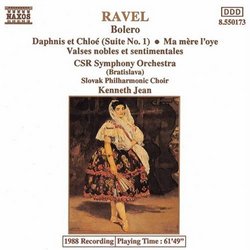| All Artists: Maurice Ravel, Kenneth Jean, Slovak Radio Symphony Orchestra (Bratislava), Slovak Radio Symphony Orchestra Bratislava Title: Ravel: Boléro; Daphnis et Chloé; Ma Mère l'oye; Valses nobles et sentimentales Members Wishing: 0 Total Copies: 1 Label: Naxos Release Date: 6/30/1992 Genre: Classical Styles: Ballets & Dances, Ballets, Historical Periods, Modern, 20th, & 21st Century Number of Discs: 1 SwapaCD Credits: 1 UPC: 730099517324 |
Search - Maurice Ravel, Kenneth Jean, Slovak Radio Symphony Orchestra (Bratislava) :: Ravel: Boléro; Daphnis et Chloé; Ma Mère l'oye; Valses nobles et sentimentales
 | Maurice Ravel, Kenneth Jean, Slovak Radio Symphony Orchestra (Bratislava) Ravel: Boléro; Daphnis et Chloé; Ma Mère l'oye; Valses nobles et sentimentales Genre: Classical
![header=[] body=[This CD is available to be requested as disc only.]](/images/attributes/disc.png?v=430e6b0a) ![header=[] body=[This CD is unavailable to be requested with the disc and back insert at this time.]](/images/attributes/greyed_disc_back.png?v=430e6b0a) ![header=[] body=[This CD is available to be requested with the disc and front insert.]](/images/attributes/disc_front.png?v=430e6b0a) ![header=[] body=[This CD is unavailable to be requested with the disc, front and back inserts at this time.]](/images/attributes/greyed_disc_front_back.png?v=430e6b0a) |
Larger Image |
CD DetailsSimilar CDs
Similarly Requested CDs
|
CD ReviewsMonotonous Boléro Leslie Richford | Selsingen, Lower Saxony | 12/11/2004 (3 out of 5 stars) "If, as one might expect, it is Ravel?s ever-popular ?Boléro? you are looking for, then I suggest you move on: the Czecho-Slovak Radio Symphony Orchestra directed by Kenneth Jean takes the piece too monotonously. The soft, slow beginning is done quite well, and there is a certain sensuousness to the clarinets, but as the tension mounts and the piece reaches its (in-)famous climax, one has the feeling that Jean is too rigid, too bound to the written notes, too determined to demonstrate Ravel?s simple rhythmic structure and not interested enough in creating genuine excitement, let alone eroticism.
However, this disc contains three other pieces by Ravel, and here I had the feeling that Jean had, on the whole, done a very good job. ?La Mère l?Oye? (Mother Goose) was originally a seven-movement piano piece for children, but Ravel himself orchestrated it and turned it into a five-movement orchestral fairy-tale. This (1912) was the age of impressionism in literature, and Ravel breaks through traditional barriers while managing to make his music both tuneful and programmatic. The instrumentation is fascinating, and I have enjoyed listening to ?The Conversations of Beauty and the Beast? over and over again. The ?Valses nobles et sentimentales? originated about the same time, and here Ravel manages to combine reminiscences of Schubert with a musically ambiguous language that sounds highly modern and could hardly have less in common with Schubert. Finally, there is the first of the two suites from the ballet ?Daphnis et Chloë?, a piece demanding a large orchestra and choir ad libitum. Even without the ballet or any information about its action, the music is able to bind me spellbound for its 12 or so minutes duration, and although the Slovak Philharmonic Choir seems to have been recorded without additional microphones, the singers sound, although a little distant, absolutely excellent. The sound quality of this 1988 production from Bratislava in Slovakia is above-average for early Naxos, although there is a certain amount of hissing in the background reminiscent of re-mastered analogue tapes. And the empty Czechoslovak Radio Concert Hall does cause a certain amount of echoing and harshness on crescendos. " |

 Track Listings (17) - Disc #1
Track Listings (17) - Disc #1









![The Best Of Kansas [Remaster]](https://nationalbookswap.com/cd//m/43/0743/10743.jpg)






